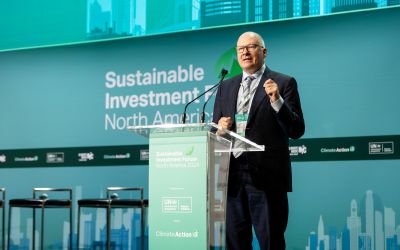All roads lead to Paris: Looking ahead to the low-carbon transition
The need to respond to climate change is triggering perhaps the largest and fastest economic transition since the Industrial Revolution.

The need to respond to climate change is triggering perhaps the largest and fastest economic transition since the Industrial Revolution. That transition—driven by policy, public concern and innovation—will create and destroy enormous amounts of value, posing challenges for investors attempting to navigate a fundamental reshaping of the global economy.
Over recent decades, an overwhelming consensus has emerged among climate scientists of the need to substantially decarbonize the global economy by the second half of this century. That consensus is reflected in the international policy framework created by the Paris Agreement on climate change, and the policies that national governments are increasingly putting in place to encourage this decarbonization.
Meanwhile, investors are expressing growing concern about the impacts of climate change, and educating themselves on what solutions the market can offer them when it comes to their climate investing asset allocation strategies. This, in turn, drives the development of new technologies and business models that will ultimately deliver the low-carbon economy.
Our own analysis indicates that the green economy is a global and well diversified approximately $4 trillion opportunity for investors, representing 6% of the market capitalization of all global listed companies. The update of our Green Revenues data model, which identifies 133 micro sectors that cover the full range of green economic activity, finds around 3,000 companies with material exposure to the theme. The Green Revenues Classification System features high overlap with the EU Taxonomy, providing a standard for reporting excellence set to be implemented by the end of 2021.
For large institutional investors who are broadly invested across the entire economy, successfully navigating the climate transition, both in terms of avoiding risk and grasping opportunity, can present some challenges. The first lies with the ubiquitous nature of exposure to transition risk across the global economy. Every large company is, to a greater or lesser extent, responsible for greenhouse gas emissions, whether directly, in their operations, or indirectly, from the energy they buy or from the emissions produced in supply chains. Large investors cannot simply divest their way out of the problem—and many are not keen to take that route currently.
The second challenge is in understanding the relative extent of climate transition risk between companies, and in understanding which ones are positioning themselves most effectively for a decarbonized world. Basic metrics are increasingly available: many companies now report on their direct emissions and those associated with their energy use, but such carbon footprints tell only part of the story. For example, a traditional car manufacturer and an electric car maker may have similar direct emissions, but the latter is much better positioned for the low-carbon transition than the former.
That is a simple example of a thorny calculation. Investors have struggled to understand what the transition to a low-carbon economy will look like over the coming decades for different companies and different sectors. So, the question becomes: how should investors assess an individual company’s preparedness for this transition, and how should they respond to that in their investment decisions and ownership practices?
In an attempt to form a view on these questions, the Church of England National Investing Bodies (Church of England Pensions Board, the Church Commissioners and CBF Funds) and the Environment Agency Pension Fund came together to launch the Transition Pathway Initiative (TPI). These investors set out to develop a tool to transparently assess the progress of companies towards the low-carbon transition.
The TPI tasked the London School of Economics with developing a framework to assess industry sectors and individual companies, and uses data provided by FTSE Russell. The TPI is making an important contribution to global investor stewardship efforts on climate, working alongside the Principles for Responsible Investment and as a partner to the Climate Action 100+, an investor initiative that is engaging with the world’s “systemically important emitters” to encourage them to reduce their carbon emissions.
Since the launch of the TPI in 2017, 80 investors have pledged their support for the initiative, representing around $21 trillion in combined AUM and advice (as of July 2020).
The TPI methodology generates assessments against two metrics. The first, management quality, is based on an evaluation of, among other things, a company’s climate policies, emissions reporting and verification, targets, strategic risk assessment and executive remuneration. This evaluation is aligned with the key focus areas of the Taskforce for Climate-related Financial Disclosures.
The second, carbon performance, uses modeling from established institutions (e.g. the International Energy Agency) to translate international emissions goals into sectoral benchmarks. This enables an assessment of whether a company’s performance is in line with national emissions pledges made at the time of Paris Agreement, or with global average temperatures rising no more than 2°C, or the with the more ambitious below 2°C scenario.
As of July 2020, more than 330 publicly listed companies in 16 carbon-intensive sectors had been measured against the methodology—providing the basis for institutional investors to take action regarding their investment exposure to the low-carbon transition, and in engaging with investee companies that are failing to adequately respond.
The TPI’s assessments can also be used in a portfolio context, for example alongside more traditional measures of ‘climate exposure’. In partnership with the TPI and the Church of England’s Pensions Board, FTSE Russell has developed an investable index series that combines the two TPI scores with three additional metrics—a company’s carbon emissions, fossil fuel reserves, and the proportion of its revenues from the green economy.
By under- and over-weighting constituents depending on their performance against the five indicators, the FTSE TPI Climate Transition Index offers economy-wide exposure that takes in account the risks and opportunities presented by the low-carbon transition. The index over-emphasizes the TPI metrics in order to explicitly capture them in index and portfolio outcomes. By doing so, it also provides investors with an engagement tool that is directly linked to investor efforts to encourage companies to manage the climate transition.
While the index reduces exposure to high-carbon companies (by 33% compared with the benchmark) it delivers returns that mirror the broader market, with a roughly 1% tracking error. Crucially, it doesn’t exclude any sector—the index currently contains two oil companies, for example.
This talks to a key aspect of TPI’s work: engagement with carbon-intensive companies to encourage them to make the necessary transition towards the low-carbon economy. As we have found with other responsible investment benchmark indexes, the failure to meet transparent requirements for index inclusion can act as a powerful motivator for company management to improve performance.
Long-term and broadly exposed institutional investors have a great deal at stake as the global economy decarbonizes. They are also critical agents of change, possessing enormous power to encourage timely and economically efficient decarbonization by the portfolio companies. The work of the TPI, and the tools and techniques it has enabled, will play an important role in these processes.
To learn more about FTSE Russell click here:
© 2020 London Stock Exchange Group plc (the “LSE Group”). All information is provided for information purposes only. Such information and data is provided “as is” without warranty of any kind. No member of the LSE Group make any claim, prediction, warranty or representation whatsoever, expressly or impliedly, either as to the accuracy, timeliness, completeness, merchantability of any information or of results to be obtained from the use of FTSE Russell products or the fitness or suitability of the FTSE Russell products for any particular purpose to which they might be put. Any representation of historical data accessible through FTSE Russell products is provided for information purposes only and is not a reliable indicator of future performance. No member of the LSE Group provide investment advice and nothing contained in this document or accessible through FTSE Russell products should be taken as constituting financial or investment advice or a financial promotion. Use and distribution of the LSE Group data requires a licence from an LSE Group company and/or their respective licensors.



_400_250_80_s_c1.jpg)


